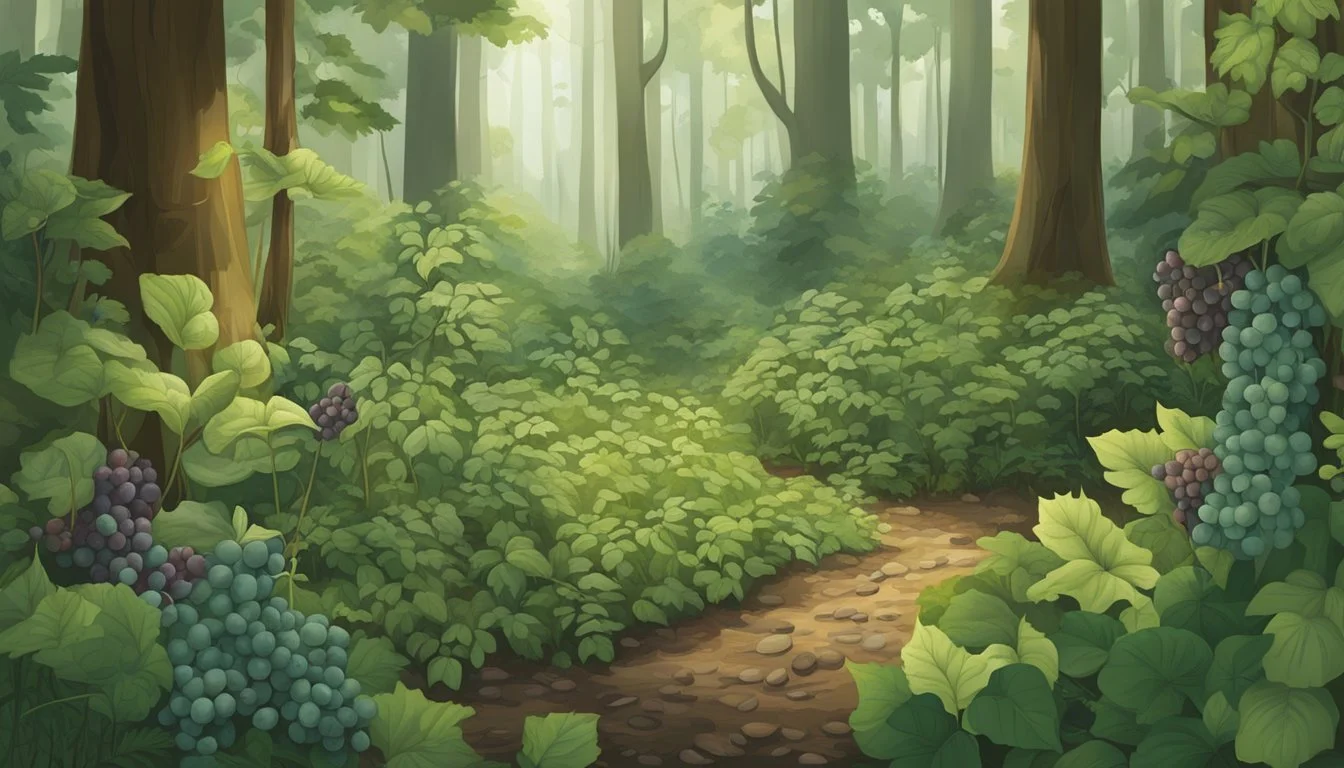Allegheny Plateau Native Edible Plants
A Guide to Wild Foraging and Sustainable Harvesting
The Allegheny Plateau in Pennsylvania is home to a rich variety of native plants, many of which are edible and have been used for centuries by indigenous peoples and early settlers alike. These plants not only provide nourishment but also play a vital role in maintaining the region's ecological balance. Among the most notable native edible plants in the Allegheny Plateau are the Allegheny Serviceberry, Black Cherry, and American Cranberry.
The Allegheny Serviceberry features white-tinged-pink, bell-shaped flowers in the summer and produces edible red berries in the fall, which often remain on the plant through winter. These berries are not only a food source but also attract wildlife, contributing to biodiversity. Black Cherry, abundant in the region, offers small but edible fruits that vary in sweetness, making them a versatile addition to a native food garden.
American Cranberry, native to northeastern North America, thrives in the Allegheny Plateau’s cooler climate and acidic soils. Cranberries are well-known for their use in sauces and preserves, adding a tangy flavor to various dishes. Growing these native plants supports local ecosystems while providing gardeners with unique and sustainable food sources.
Understanding the Allegheny Plateau
The Allegheny Plateau is a diverse and complex region characterized by varied geography, climate, and significant ecological contributions. This section explores the distinctive geographical features, unique climate, and its ecological importance to flora and fauna.
Geography and Ecoregion
The Allegheny Plateau spans parts of New York, Pennsylvania, Ohio, and West Virginia. This region is largely part of the Appalachian Mountains and is divided into several ecoregions, including the Northern Allegheny Plateau and the High Allegheny Plateau.
Characterized by high hills, sharp ridges, and narrow valleys, the landscape is a mix of sandstone, siltstone, shale, and coal. Glaciation has also shaped parts of the plateau, especially in the Northern Allegheny region. The US EPA's Level 4 Ecoregion Codes help delineate these areas, providing a framework for conservation and study.
Climate and Environmental Conditions
The climate of the Allegheny Plateau varies significantly across its regions. It experiences four distinct seasons: cold winters, warm summers, and moderate spring and fall periods. Due to its elevation and geographical diversity, moisture levels and sunlight exposure can vary, impacting soil pH and plant growth.
Rainfall is moderate to high, supporting lush woodlands and dense forest canopies. The diverse climate zones within the plateau include Appalachian Oak forests and mixed woodlands, crucial for maintaining the region's rich biodiversity.
Significance to Wildlife and Ecosystem
The Allegheny Plateau is a vital habitat for a variety of wildlife and plays an essential role in North America's ecological network. Birds, mammals, and insects such as bees and butterflies thrive here, benefiting from the rich vegetation and diverse habitats.
Pollinators, including hummingbirds, contribute significantly to the reproduction of native plants. The plateau's ecosystems support a wide range of species, from woodland creatures to aquatic life in its streams and rivers. The interplay between plants and animals is crucial, ensuring the health and sustainability of this ecoregion. The environmental balance maintained here supports both wildlife and human needs, underlining its ecological value.
Types of Native Edible Plants
The Allegheny Plateau is home to various native edible plants, ranging from fruiting trees and shrubs to herbaceous plants and groundcovers. Understanding these diverse plants can enhance your appreciation of regional flora and support sustainable gardening practices.
Fruiting Trees and Shrubs
Allegheny Serviceberry: This deciduous small tree produces clusters of blueberry-like fruits that are sweet and nutritious. The berries are often used in pies and preserves.
American Cranberry: Thrives in moist, acidic soil with a pH between 4.0 and 5.2. The bright red berries are famed for their tartness and can be used in sauces, salads, and beverages.
Pawpaw: Known for its large, banana-like fruits, pawpaw trees prefer well-drained, fertile soil. The fruit is sweet and custard-like, making it a favorite for fresh eating and desserts.
American Persimmon: This tree produces orange, plum-like fruits with a sweet, honeyed flavor after the first frost. The fruit can be eaten fresh or used in breads, puddings, and beverages.
Blackberries and Blueberries: These shrubs are well-suited to the region's environment. Both produce abundant berries that are excellent for fresh eating, jams, and baking.
Herbaceous Plants and Groundcovers
Ramps (Wild Leeks): Ramps are a type of wild onion with a strong garlic-onion flavor. They grow in moist, shaded woodlands and are highly prized in culinary dishes, adding a unique flavor to soups, pestos, and sautés.
Sunflowers: These plants, known for their tall stalks and bright yellow flowers, provide edible seeds rich in oil and nutrients. Sunflower seeds are versatile, eaten raw, roasted, or processed into oil.
Groundcover Berries (Strawberries): Wild strawberries serve as an excellent groundcover, offering sweet, small berries. They help prevent soil erosion and add a delicious fruit to your garden.
Herbs and Greens: Many native herbs, such as mint and various wild greens, can be used for culinary purposes. These plants are often rich in vitamins and can be used fresh in salads, teas, and various dishes.
Nuts (Black Walnut, Hazelnut): Nut-bearing trees like black walnut and hazelnut not only provide shade but also produce nutritious nuts. These nuts can be eaten raw or used in baking and cooking.
Rhizomes: Plants like wild ginger spread through rhizomes and can be used to flavor foods. They often thrive in shaded, wooded areas and contribute to a diverse garden ecosystem.
Cultivation and Harvesting
Native edible plants of the Allegheny Plateau thrive in specific conditions involving soil type, fertilization, and proper harvesting methods. Optimal growth and fruitful yields depend on these critical factors.
Soil and Fertilization
To cultivate native edible plants, it is essential to start with the right soil. These plants typically prefer acidic and well-drained soil. A soil pH between 4.0 and 5.5 works best, especially for plants like American cranberries.
Regular testing of the soil pH and nutrient levels is crucial. Organic matter, such as compost or leaf mold, can be added to improve soil structure and fertility. Fertilization should be light but consistent, using organic fertilizers rich in nitrogen and phosphorus to support growth.
Planting and Maintenance
Planting should ideally occur in early spring or late fall. Ensure proper spacing for each plant to allow for air circulation and reduce disease risk. For example, blueberries require about 4-5 feet of space between bushes.
Low maintenance strategies are attractive for these native plants. Mulching with pine needles or wood chips helps retain soil moisture and suppress weeds. Minimal pruning is necessary but should be done to remove any dead or diseased wood.
Harvesting Techniques
Harvest times vary among different plants. For instance, blueberries can be picked in mid to late summer, while cranberries are typically harvested in the fall. It's important to pick fruits at their peak ripeness for the best flavor and nutritional value.
Other plants like the Allegheny spurge require careful root harvesting. Use tools like a sharp spade or garden fork to dig around the plants without damaging the roots. Always harvest early in the morning or late in the evening to ensure the harvested parts remain fresh.
Proper technique ensures that the plants can continue to thrive and produce in subsequent seasons.
Edible Plants in Landscaping
Integrating edible plants into landscaping offers numerous benefits such as beautifying the garden, supporting local wildlife, and promoting sustainability. These points will be discussed in greater detail.
Designing with Edible Plants
Incorporating edible plants in landscape design can create vibrant and functional spaces. Blueberries, for example, provide attractive foliage and produce berries throughout the summer. They flourish in acidic soil, making them perfect for rain gardens.
Using diverse plant species can enhance the aesthetic appeal. For instance, amaranth adds lush green foliage and showy, fragrant flowers to the garden. Evergreen herbs like rosemary contribute year-round greenery and can be shaped into attractive hedges.
When planning, consider plant height, spread, and growth patterns. Integrate these plants along borders, as ground cover, or even as low-maintenance key focal points. This approach ensures the garden remains practical and aesthetically pleasing.
Sustainability and Ecosystem Services
Using native edible plants promotes sustainability and strengthens local ecosystems. These plants are naturally adapted to the region, requiring less water and fewer chemical inputs. This lowers maintenance efforts and encourages environmentally friendly gardening practices.
The integration of such plants, like cranberry bushes, contributes to vital ecosystem services, such as soil stabilization and water filtration. Soil health is maintained with minimal intervention, which is beneficial for long-term garden vitality.
Additionally, native flora supports pollinators and other beneficial insects, enhancing biodiversity and resilience. By fostering a balanced ecosystem, gardeners ensure the sustainability of their landscapes and a reduced environmental footprint.
Wildlife Attraction and Support
Native edible plants are crucial for attracting and supporting local wildlife. Plants like blackberries and chokeberries offer critical food sources for birds and mammals, promoting healthy wildlife populations.
Evergreen herbs and shrubs provide year-round shelter and nesting sites. For instance, the dense foliage of juniper bushes offers protection and food through their berries.
Creating a habitat rich with diverse species promotes a thriving environment. Incorporating such plants ensures that the garden remains not only a functional space for humans but also a supportive habitat for wildlife. This approach aligns with eco-friendly landscaping principles and enhances the area's overall ecological health.
Edible Plant Profiles
Native to the Allegheny Plateau, many edible plants offer unique flavors and nutrition. Highlighting key species such as the Allegheny Serviceberry, Pawpaw, and Ramp, this profile provides essential information for enthusiasts and foragers.
Allegheny Serviceberry Profile
The Allegheny Serviceberry (Amelanchier laevis) is a deciduous shrub known for its white flowers in the spring and sweet berries in the summer.
Description: The Serviceberry stands 15-25 feet tall, with a smooth, gray bark and oblong leaves that turn orange-red in the fall.
Propagation: Serviceberries propagate through seeds or cuttings. Seeds require cold stratification.
Cultivars: Popular cultivars include ‘Autumn Brilliance’ and ‘Cumulus’.
Harvest: Berries ripen in late spring to early summer. They are deep purple and can be eaten fresh or used in pies and jams.
Wildlife: Birds and mammals favor these berries, aiding in seed dispersal.
Pawpaw Profile
The Pawpaw (Asimina triloba) is often called the "forgotten fruit" due to its tropical flavor and custard-like texture.
Description: Growing 15-30 feet tall, it has large, drooping leaves and maroon flowers that appear before the foliage.
Propagation: Typically propagated by seeds, which need a period of cold stratification. They can also be propagated through root suckers.
Cultivars: Notable cultivars include ‘Sunflower’, ‘Shenandoah’, and ‘Susquehanna’.
Harvest: Fruits are harvested in late summer to early fall when they are soft to the touch. Each fruit can weigh up to a pound.
Wildlife: Pawpaw fruits are eaten by raccoons, squirrels, and birds, which helps in seed dispersion.
Ramp Profile
Ramps (Allium tricoccum), also known as wild leeks, are prized for their pungent taste.
Description: Ramps produce broad, green leaves in the spring, followed by a single stalk with white flowers in mid-summer.
Propagation: Best propagated from divisions or seeds. Seeds should be sown in the fall for optimal results.
Foliage: The leaves are edible and have a strong, onion-garlic flavor, making them popular in various recipes.
Cultivation: Ramps prefer shady, moist, and well-drained soil, often found in deciduous forests.
Harvest: Leaves are harvested in early spring before the plant flowers. The roots can also be harvested, but sustainable foraging practices must be followed to avoid depletion.
Following the profiles of these native edibles will help you identify and enjoy the unique plants of the Allegheny Plateau.
Conservation and Ethical Foraging
Foraging in the Allegheny Plateau requires mindful practices to protect both the environment and native plant populations. This involves understanding responsible foraging methods and supporting sustainable ecosystems through careful plant management.
Responsible Foraging Practices
Responsible foraging begins with proper identification of plants to prevent the unintentional harvesting of endangered or toxic species. It's imperative to have a reliable field guide and, when in doubt, consult local experts.
Take only what you need, leaving enough for wildlife to sustain their habitats. Harvesting only 10-20% of an area ensures that plants can continue to grow and reproduce. Areas should be visited infrequently to avoid depleting resources.
Harvesting methods should also minimize damage. For instance, using sharp tools for clean cuts allows plants to heal faster, promoting regrowth and maintaining ecosystem health.
Supporting Native Plant Populations
Native plants are crucial for maintaining ecological balance. Conservation efforts include supporting habitats where these plants thrive and avoiding the introduction of invasive species that may outcompete them.
Engaging in activities like propagation can bolster native plant populations. Collecting seeds responsibly and learning techniques for growing native species can support local ecosystems.
Educating oneself and others about the value of native plants and ethical foraging practices is vital. Participating in local conservation programs can also make a significant impact, ensuring that these valuable resources are preserved for future generations.
Recommended Uses and Recipes
Native edible plants from the Allegheny Plateau offer a range of culinary and medicinal benefits. Understanding how to use these plants effectively can enrich both your diet and overall well-being.
Culinary Applications
Chicken of the Woods: This mushroom, easily identified by its vibrant orange color, makes an excellent meat substitute due to its firm texture and savory taste. It can be sautéed, grilled, or added to soups and stews.
Aronia Berries: Also known as chokeberries, these berries are rich in antioxidants. They can be used in jams, jellies, and smoothies. Due to their tart flavor, they pair well with sweeteners like honey or sugar.
Blueberries and Blackberries: These versatile berries can be eaten fresh or used in pies, cobblers, and muffins. They can also be preserved by canning or freezing for later use.
Juniper Berries: Known for their sharp flavor, juniper berries are widely used in marinades and rubs for meat, particularly game. They are also used in making gin and can be added sparingly to stews and casseroles.
Medicinal Uses
Chicken of the Woods: This mushroom is traditionally used to boost the immune system. It contains compounds that may have antibacterial and antiviral properties.
Aronia Berries: These berries are heavily used in traditional medicine to improve cardiovascular health and reduce inflammation. They are also known for their potential role in controlling blood sugar levels.
Juniper Berries: Used to treat digestive issues and urinary tract infections, juniper berries also have anti-inflammatory properties. They are often made into teas or tinctures for medicinal uses.
American Cranberry: This plant is utilized for its health benefits, particularly in preventing urinary tract infections. The berries are high in antioxidants and vitamin C, making them useful in immune support formulations.
The integration of these native plants into daily life not only enhances flavor but also contributes to overall health.
Further Resources and References
For those interested in deepening their knowledge about native edible plants in the Allegheny Plateau, a wealth of references and online materials are available to support further research and practical application. These sources include curated bibliographies and online platforms dedicated to native plants and regional ecology.
Bibliography
Key texts provide in-depth discussions on the flora of the Allegheny Plateau.
Native Plants of the Northeast: A Guide for Gardening and Conservation by Donald J. Leopold.
Focuses on identifying and cultivating native plants in the Northeastern U.S., which includes Pennsylvania.
Bringing Nature Home: How You Can Sustain Wildlife with Native Plants by Douglas W. Tallamy.
Highlights the ecological benefits of using native plants to support local wildlife.
University of Pittsburgh Library Resources
Offers extensive collections on Western Pennsylvania's native plant species, including historical agriculture resources.
These references provide foundational knowledge and practical advice for anyone engaged in gardening or studying native species.
Online Resources
Several online platforms and organizations provide valuable information on native plants in the region:
Audubon Society of Western PA: Lists plants native to Southwestern Pennsylvania. They host detailed plant descriptions and benefits.
Garden Club of Allegheny County: Focuses on promoting the use of native plants in local landscapes.
bplant.org: Features interactive maps and descriptions of the Allegheny Plateau’s ecological regions, including the Pittsburgh Low Plateau.
Penn State Extension: Offers educational resources and frequently updated information on agriculture and native gardening practices.
These platforms are excellent for accessing plant lists, learning more about the region's unique ecosystems, and finding specific in-region search tools.









